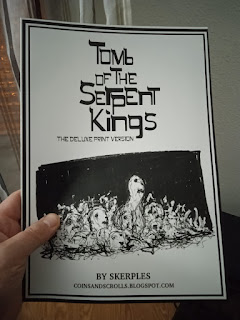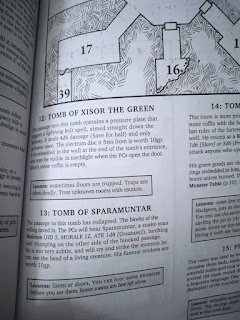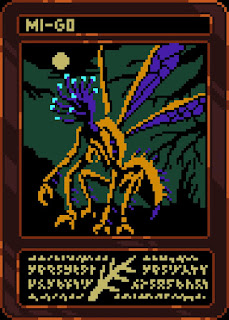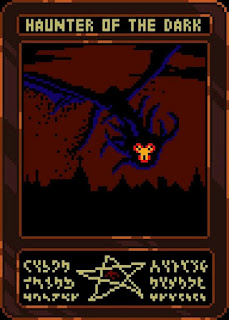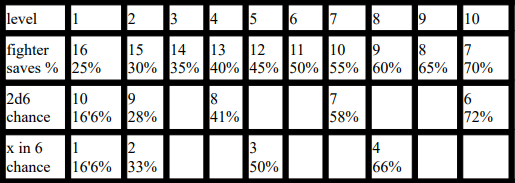(Warning: This post is heavy on numbers. Is meant to be used as a reference)
Working after the steps of
Homebrew Homunculus again, I was trying to make my own try at taking damage rolls from combat. One hit is one hit, so it takes one hit dice. Easy! Is fast, simple and requires almost no conversion. But of course, this started the design train: you change a little thing, and then you change another one to go with that, and end up having a whole different game.
I thought on making the fighter do multiple attacks instead of getting to hit bonuses. Even if the average damage per round was the same, there could be the chance that each round none of the attacks landed, or any number of them would. This way, there would be a kind of "variable damage" without any damage roll taking place!
But there is a number of how many d20s one can roll simultaneously in a confortable way. So I ended up doing what I had already done other times, and made it with d6. Only that, this time, I did the math.
This an orientative chart on the damage output of an attacking PC (where a 100% represents doing consistently 1 hit dice of damage per turn over time) depending on their class/level and his/her opponent AC.

This other table shows the % damage output of Fighter 1 (a just made level 1 fighter) versus enemies with various ACs (still not assigned what kind of AC do these numbers represent, so I described them as Base, fightey, soldier and tank). He rolls 1d6. Fighter "2" rolls 2d6 and Fighter "3" rolls 3d6. Each result equal or over the AC is a hit, and again, the chance of dealing consistently one hit every turn is represented as 100% damage.
If we look at fighter 1 alone, we see that AC 3 is slightly easier to hit than the "base" in d20. AC4 is a little worse than d20 leather (actually corresponds to wearing just a shield in the original), AC 5 being roughly equal to chain and AC 6 being an enchanted +1 plate and a shield.
Then it shows the chances of hitting the same enemies by fighter "2" and fighter "3". The brackets are there because we dont know yet at which level would a character get their second and third attacks.
As I see it, if we take the AC6 (Tank) to be roughly equivalent to Enchanted Plate + Shield, the chances to hit are pretty similar than if Fighter "2" was a 7th level fighter and Fighter "3" was a 10th. Well, this can be worked with. We can make it so the fighters gain other bonuses like weapon expertises, AC bonuses by using armor or extra HD until then, and the additional attacks are gained at those levels. But I'd lean towards granting them the attacks earlier, as otherwise the fighter hasnt any kind of "to hit" bonus until then.
But if we look at the lowest ACs, we see that the increments compared with their d20 counterparts are crazy: the chance to hit base AC is doubled, and the same could almost be said about the next higher one. AC5/chain stands a little better with just slight increments. This informs us that our new high level fighters are roughly equally capable vs higher armored foes, but are about double as capable vs unarmored foes or lowly armored mooks. This could be seen as a problem or as a boon. For one, I can see it fixing the problem in which high level fighters had to slay hordes of mooks one by one. Now they can just send an attack to three 1HD enemies at once with a great chance of killing them, without the aid of any cleave or "you can attack as many 1hd enemies as your level" houserule.
But why is the "2d6 take worst" represented at the top of the table? Well, that is for wizards and other non-fighters. While in the d20 combat all classes start with the same "to-hit" bonus (with some of them having a +1 for fighters) in the practice the fighters always deal a little more damage because they can afford using all weapons, while wizards are restricted to daggers and darts.
By making wizards roll with disadvantage, we make the a distinct gap between fighters and wizards even at level 1, which feels very right to me.
Then, the idea is this: when PCs use lesser or tricky weapons like daggers or such, they roll as 1 "combat level" less, so fighters roll with disadvantage at level 1. Wizards still roll with disadvantage, there are no lower levels than 2d6 take worst.
This solves two problems right the early stages of the game design: it creates variable weapon damage when there was none, and implants an invisible system of weapon restrictions: wizards can carry and use any weapon, but they won't do more damage than they would with a staff or a dagger anyways.
Though AC6 is the maximum available, you can always make monsters tougher by other means. For example, a giant might only be attacked after you dodge his attack first. If you are hit by him, you suffer the wound and cannot act for one turn. I kind of like this limitation because it invites me to be more creative with monster rules.
How does strength, magic swords, etc factor into this? Well, this is the foundation. We will have to slowly figure out the rest around it, but that will be part of a new entry. For the sake of making reading this easier, the provisional codename and blog tag for this project will be d6 d&d.
On the other hand, working the saves is very straightforward. Here is how I would set them (taking the fighter saves as a guide) using 2d6 vs target number, or 1d6 roll under (the one I am using right now). I dont think I'd advance them more than that. A 100% chance of saving should never be reached, and there has to be room for other bonuses that might come from elsewhere.
(Notice the drop on the saving chance for first level characters. Today I had one guy rolling his 1 just before running into a pit trap with only one hit remaining. Yeah!)
******************** EDIT: ***************************
I have been working deeper on this. I will drop here two more tables, and I will explain in a moment.
This one is the classic to-hit, ascending AC table. Leather and Chain are merged halfway into a new armor (a kind of "light armor"). To check how much would a shield add to each armor, just add a 5% to it. The percentage is the rate in which a hit is delivered each turn, with a 100% meaning that the character will stastically deliver a hit per turn.
The next table shows the same, but using the d6 pool. Armor is arranged in two types: Light and Heavy. This is mainly because each step up and down the AC means much more in this situation, and I didn't want armor to be so much decisive in combat. Instead, being a fighter gives you +1 AC straight away, moving you beyond non-martial classes right at level 1. Fighters (and clerics if you use them) are also the only ones able to use plate, so wizards and thieves have to search for alternative ways to go higher than AC4.
The number in brackets is the damage if the target uses a shield. Shields deflect 1/3 of the succesful strikes. So, when you are hit, you roll in this (provisional) table:
6-deflect
5-deflect if you are a fighter
4-hit
3-hit
2-hit and shield breaks if enemy is Strong AND has a mace/axe
1-hit and shield breaks if enemy is Strong or has a mace/axe.
If you are hit by a flail, you roll twice and get the worst result. They are designed to bypass shields after all!
I love how this approach creates a lot of granularity with very little. Yes, the shield roll adds another roll to combat, but they are only going to come up with shield-wearing characters and monsters (which are not too many). The same is true for flails. And we took out damage rolls anyways, so in the end there are much less rolls involved.
In this way, shields are comparativelly much more protective the less armor you wear, which makes some sense given on how they are supposed to behave in real life. A fighter in loincloth gets much more relative cover by a shield than a fighter in plate does, even if the total numbers are higher for the latter.
The shield roll can also adapted to monsters that don't have shields, be it to increase their ACs or for other purposes. For example to add “counterattack” abilities; such as “additionally to its normal attacks, a dragon breathes fire over an attacker on a shield roll of 6”
The next point: 2 handed weapons. When you get hold of a greatsword or greataxe, you are given a red die instead of your normal one. When that die comes up a 6, your weapon crits, doing 2 hits of damage. As you go building your pool you get more d6, but only your red dice can cause critical hits.
The increase in damage by armor and by levels is shown in the F1, F2, F3 d6 crit rows. As you can see, the damage increases much more in comparison against the more armored enemies than it does against the less armored; which makes them specially important when fighting giant enemies or fully armored knights. Again, I love when simple mechanics help portraying something logical in-game, even if its not excesivelly realistic. As levels go up, the crit die matters a little less, but remains a great advantage.
Next: adjusting fighter improvements to fighter levels.
d6 F1 works similar enough to d20 Fighter 1 when targeting plate armor. d6 is a little worse, but d6 with a 2handed weapon is a little better, so one evens the other. The same is true for fighter/light armor and the other ACs when using shields.
For Fighter/naked and Wizard/naked, one handed weapons work a little better than in the d20 counterpart, if compared with the same leather/chain median, with 2handers being way better.
Is hard to choose to which Fighter attack levels do d6 F2 and d6 F3 correspond, as damage output is exponential the less AC your enemy has. Adjusting the levels VS fighter/plate armor leaves lesser ACs much easier to hit. Adjusting to lesser ACs leaves AC6 much harder to hit.
Personally I feel that they should err on the side of generous; for two reasons. First, the d20 fighter will also benefit from multiple bonuses like strength (available even at level 1) or magic weapons; which on the d6 counterpart are very hard to implement. Second, there are only 2 pool upgrades, and until then the fighter has not much progression beyond getting more HP. If I wait for the fighter to have the corresponding "firepower" on the d20 to give him the pool increment, he will be always under the power curve. If I give them a little earlier, he will be sometimes over the curve, and sometimes under it, so the "power curve" will be more tightly followed, paradoxically.
Following this points, I can see F2 adjusting to fighter 3 or 4 (level 6- 7 for a wizard), and F3 being somewhere around levels 7 or 8. If using a level 10 cap, wizards should never achieve this combat range.
Next: Lesser Weapons.
Daggers, staves, maybe bows. I originally had two ideas for them, which are:
- rolling with disadvantage
- rolling normally, but on a 6 you must roll again. You keep the second roll, and this time a 6 is a hit.
I like the second one better, as it represents the attacker using that result to "find a weak point" in the enemy's defence, then you are able to hit normally. This decreases drastically the effectiveness of the weapon towards the greater versions or ACs, but still allows for 2 handed, lesser weapons strike x2 on a hit.
The math for both approaches VS ac is unfolded at the table above.
When you get an increment of the pool, they also go up one step, so F2 rolls 1d6, and F3 rolls 2d6.
Alternativelly, fighters roll all their normal dice and just roll again if the highest one is a 6. This one is very wild, as they are more likely to roll again the more dice they have, but in the end they get surely better output anyways. I should do the math but a priori it is cool and feels organic. If there is some kind of "bow expertise" might work by allowing spending a turn aiming to automatically get the first 6.
This approach also allows for easy unarmed combat: You must roll again on a roll of 5 or 6, and in your second roll all numbers are valid.
Note to myself: If I end up doing weapon expertises, they should not increase dice rolled in any way, but work as a side help, never equiparating themselves to a "fighter level" but useful in all levels. A good one for trained swordsmen is "you get an extra attack once per combat". A good one for martial artists might have something to do with shield rolls.
Edit: Note to myself #2: As maces/axes have a small upside on shield rolls, trained or not, swords should have one too. A good idea is to have them increase the initiative by one level (see the post I did later about Initiative without rolls)






